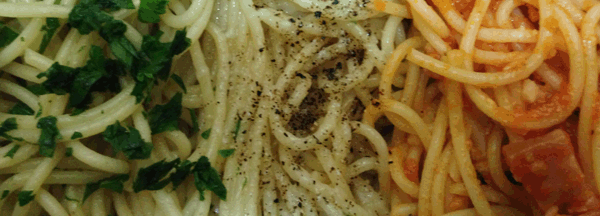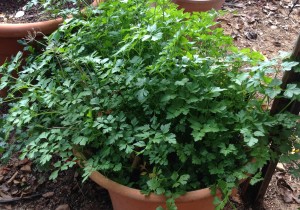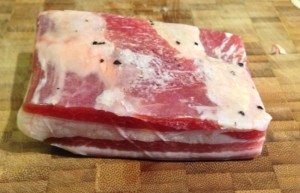Being a second generation Australian-Italian, I have grown up on a very carbohydrate rich diet consisting of copious amounts of pasta (not that I’m complaining). I think what I love about it most is that it is so versatile, and making a great pasta dish requires so little effort, and herein lies the motive for this post.
I want to talk about three of my favourite pasta dishes that really do require minimal effort to make:
- Spaghetti Aglio e Olio (Garlic and Oil)
- Spaghetti Cacio e Pepe (Cheese and Pepper)
- Spaghetti All’Amatriciana
Each dish requires only very few, albeit high quality, ingredients. They are also the types of dishes that can be prepared in less than 20 minutes for a quick lunch or dinner. Together, they make the Italian flag (I had to have quite a big lunch to make this photo):

Aglio e Olio, Cacio e Pepe, Amatriciana
In each dish I use Pecorino Romano cheese, a sheep’s milk cheese from Lazio or Sardinia. It can be bought from many gourmet delicatessens and Italian food stores. If you can’t find it then Parmigiano Reggiano is a good, although different, alternative.
Aglio e Olio

My parsley plant, growing out of control
Aglio e Olio is a direct Italian translation of Garlic and Oil–and that is almost all there is to the dish! There is, of course, one other key ingredient that lifts it to a whole new level, and that is parsley, one of my absolute favourite ingredients. This dish is all about great ingredients, which means high quality extra virgin olive oil and super-fresh parsley; it really does make a difference. Luckily for me I have a parsley plant going wild just outside my doorstep.
Ingredients
Serves 2
- 200g spaghetti
- 3 Tablespoons extra virgin olive oil
- 25g chopped parsley
- 1-2 garlic cloves, finely chopped
- 1-2 Hot chilis, chopped
- 40g Grated Pecorino Romano cheese
Preparation
- Bring a large pot of water to the boil and add a generous pinch of salt. Salt is important in flavouring the pasta. Once boiling, add the spaghetti and stir to stop them from sticking together.
- Add the garlic and chili to a frying pan with the olive oil, and leave it to cook over a low heat, being very careful not to burn the garlic (don’t let it get too brown, it will ruin the dish). Season with a little freshly ground black pepper.
- Add the parsley to the pan of oil and garlic. Do this just before the spaghetti is cooked, to maintain the freshness of the parsley.
- Drain the cooked spaghetti but keep some of the cooking liquid aside. Add the spaghetti to the pan and toss to coat with the oil. Add the grated cheese and about half a cup of the cooking liquid, tossing to mix the cheese evenly through the pasta. If the spaghetti is still too dry and sticks together, add a little bit more of the cooking liquid.
Cacio e Pepe
Cacio e Pepe means Cheese and Pepper, and is another great dish to prepare when short on time. This one is all about the cheese, which is traditionally Pecorino Romano, which forms a beautiful sauce when mixed with the cooking liquid. It’s almost like the Italian version of Macaroni Cheese. The pepper is also quite important in this one, so I highly recommend grinding peppercorns in a grinder instead of using pre-ground pepper, which never seems to have the same depth of flavour.
Ingredients
Serves 2
- 200 g spaghetti
- 80g grated Pecorino Romano cheese
- 1 tablespoon ground black pepper
- 1 tablespoon extra virgin olive oil
Preparation
- Bring a large pot of salted water to the boil, then add the spaghetti. Stir to stop them sticking together.
- In the meantime, place the ground black pepper into a frying pan and gently roast over medium heat for a few minutes, being careful not to burn it.
- Add the olive oil to the frying pan and reduce the heat to low until the spaghetti is cooked. The oil will become infused with the pepper and help to create a very tasty sauce.
- Drain the spaghetti once cooked, being sure to keep aside some of the cooking liquid. This will be important for creating the sauce.
- Add the spaghetti to the pan with the oil and pepper. Add the grated cheese and about a cup of the cooking liquid. Toss the pasta well until everything is combined and the cheese has melted to form a creamy sauce. Add more water if the spaghetti is dry and sticking together.
I love pepper, so I sometimes go a bit crazy with it. Adjust the amount that you use to your liking.
All’Amatriciana
This is one, originating from Amatrice, that many Australian Italian restaurants serve, unlike the previous two, probably because of the love affair that so many people seem to have with bacon. It is essentially a basic tomato sauce, but driven to a whole new level of flavour with the addition of pancetta (or bacon). Pancetta is pork belly meat that has been salt cured, and hence has an intense but delicious flavour. Most gourmet delicatessens should stock it, but if you can’t find it then bacon should do (although I much prefer pancetta, it has a very different flavour). This dish is traditionally prepared with guanciale, cured pork cheek, however I have had a very hard time trying to find it here in Perth, so I just stick to pancetta.
Ingredients
Serves 2
- 200 g spaghetti
- 3 tins of whole peeled tomatoes (400g cans)
- 2 cloves of garlic, finely chopped
- 1/2 cup dry white wine
- 1 tablespoon extra virgin olive oil
- 150g pancetta, sliced into thin pieces
- Freshly ground black pepper
Preparation

A beautiful slab of pancetta, the Italian version of bacon
- Bring a large pot of salted water to the boil, but don’t add the spaghetti just yet.
- Drain the tomatoes from their juices (most canned tomatoes are packed in tomato juice–I prefer to get rid of it and just keep the actual tomatoes). Cut the end of each tomato and get rid of the seeds inside. For a smoother consistency, pulse the tomatoes a few times in a food processor until it forms a sauce-like consistency.
- In a separate saucepan, add the olive oil and garlic. Cook over a low heat until the garlic becomes soft. Add the chopped pancetta and season with some freshly ground black pepper.
- Cook the pancetta until the fat becomes transparent and soft. Bring it to the point where it is starting to become crispy, then add the white wine.
- Allow the wine to reduce a little, then add the tomatoes prepared earlier. Leave the saucepan on a low/medium heat to simmer gently, for about 20 minutes, or until the sauce has thickened and the flavours concentrated. Add the spaghetti to the boiling water so that they are ready at about the same time as the sauce.
- Toss the spaghetti with the sauce and a generous amount of Pecorino Romano cheese, adding some of the cooking water if necessary.
Thanks for your sharing on this details step by step instructions.
Pasta is my favourite food 😀
I’m thinking will the taste still be great if I’ll to add in the pancetta or bacon into Agio e Olio and Cacio e Pepe? And also I feel that Agio e Olio and Cacio e Pepe are more easier to prepared compare to All’Amatriciana, right? Probably I can try to make it myself one day :p
The dishes would no longer be traditional Aglio e Oglio and Cacio e Pepe with pancetta, but I’m sure they would still taste pretty good!
Hello I am so grateful I found your site, I really found you by mistake, while I was looking on Aol for something else, Anyhow I am here now and would just like to say thank you for a tremendous post and a all round interesting blog (I also love the theme/design), I don’t have time to look over it all at the moment but I have bookmarked it and also added in your RSS feeds, so when I have time I will be back to read a lot more, Please do keep up the excellent job.
Thanks for the kind comment Jon 🙂 I’m glad you’ve found it interesting so far! I’m not a professional chef, nor a professional food writer, but I really enjoy learning more about the culinary world and sharing it with others who share a similar interest.